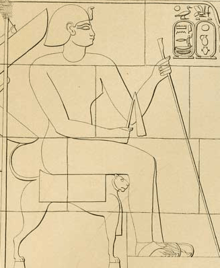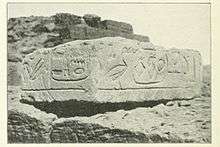Arakamani
Arakamani (also Arkamaniqo,[2] Arkakamani or Ergamenes I[1]) was a Nubian king of Meroë who ruled in the early third century BCE.
| Arakamani | |||||||||||||||||||||||||||||
|---|---|---|---|---|---|---|---|---|---|---|---|---|---|---|---|---|---|---|---|---|---|---|---|---|---|---|---|---|---|
 Depiction of Arakamani, from Meroë pyramid Beg. S 6 | |||||||||||||||||||||||||||||
| Kushite king of Meroë | |||||||||||||||||||||||||||||
| Reign | around 270 BCE | ||||||||||||||||||||||||||||
| Predecessor | Sabrakamani | ||||||||||||||||||||||||||||
| Successor | Amanislo | ||||||||||||||||||||||||||||
| |||||||||||||||||||||||||||||
| Burial | Meroë, Beg. S 6 | ||||||||||||||||||||||||||||
Biography
The only secure archeological attestations of Arakamani come from his funerary pyramid at Meroë (Pyramid Begarawiyah S 6).[3] In addition, many scholars believe that he should be identified with the Nubian king Ergamenes mentioned by the Classical historian Diodorus Siculus (Koinē Greek: Διόδωρος Σικελιώτης) in his Bibliotheca historica.[2] Diodorus writes that the powerful priesthood wanted the death of Ergamenes in order to please the gods, but because he was educated in Hellenistic culture, Ergamenes' strong will enabled him to negate this destiny and to overpower the priesthood.[4]
The events reported in this account are now interpreted as a dynastic change in relation with the transfer of the royal necropolis –and thus of the capital city– from Napata to Meroë. Thus, many scholars regard Arakamani/Ergamenes as the first king of the Meroitic phase of Nubian history, when the power base of the kingdom finally moved to its southern reaches and when African influence became stronger.[2] It has been suggested that the "Greek culture", which Diodorus claimed was the origin of Ergamenes' strong-will, should be understood as the Greco-Egyptian culture of the Ptolemaic Kingdom (305 BC–30 BC), when Egypt was ruled by a Greek dynasty.[5]

If the identification of Arakamani with Ergamenes I is correct, Arakamani provides an important chronological marker for Nubian history as Diodorus writes that he was a contemporary of Ptolemy II Philadelphus (reign 285–246 BCE) in Ptolemaic Egypt.[4] Most Nubian kings are otherwise very difficult to date precisely as well as to order chronologically.
References
| Wikimedia Commons has media related to Arakamani. |
- von Beckerath, Jürgen (1999). Handbuch der Ägyptischen Königsnamen (in German). Mainz am Rhein, Von Zabern. ISBN 3-8053-2591-6. pp. 276-77
- Török (2008), pp. 389–90 and references therein.
- Török, László (1996). Fontes Historiae Nubiorum, Vol. II. Bergen. ISBN 8291626014., pp. 566–67
- Hoskins, George Alexander (1835). Travels In Ethiopia, Above The Second Cataract Of The Nile; Exhibiting The State Of That Country, And Its Various Inhabitants, Under The Dominion Of Mohammed Ali; And Illustrating The Antiquities, Arts, And History Of The Ancient Kingdom Of Meroe ; With A Map, And Ninety Illustrations Of The Temples, Pyramids, Etc. Of Meroe, Gibel-El-Birkel, Solib, Etc. From Drawings Finished On the Spot, By The Author, And An Artist Whom He Employed. Longman, Rees, Orme, Brown, Green, & Longman. p. 314.
- Török (2008), p. 511
Bibliography
- Török, László (2008). Between Two Worlds: The Frontier Region Between Ancient Nubia and Egypt 3700 BC - 500 AD. Brill. ISBN 978-90-04-17197-8.